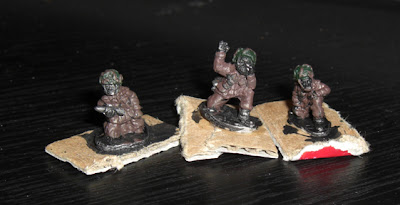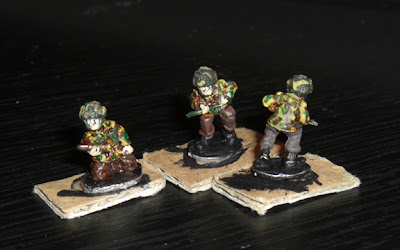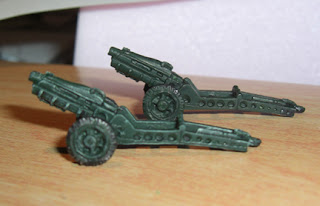I had finished painting the smocks on all the minis so I moved onto the camoflauge stripes. I did the minis in batches. First I mixed up some brown paint which was mostly "Scorched Brown" and a little "Elf Flesh" to lighten the colour. Using my thinest brush (I am in need of new ones with better tips!) I painted wiggly lines all over the smocks.

I painted more lines with a mix of 3:2:1 "Goblin Green", "Dark Angels Green" and "Scorched Brown". This gave me a more military green which blended in nicely.

With most of the painting out of the way I started to work on the plastic bases. In order to get a natural look to the bases (which are flat and untextured) plaster and "static grass" will be applied. I'll detail this process in a future article. For now I will need to prepare the bases so that the glue and plaster will have something to adhere to. To this end I have taken a blade and scored the tops of the bases.

The miniatures are then glued to the bases. Here is the command team for the platoon. The officer is directing two of his guardsmen. The arrangement on the miniatures is quite plain, but I plan to be a bit more creative with future bases. For now I am content with just getting the platoon finished.
 Below is a picture of a pair of gun teams ready for basing. The howitzers are not yet glued on. If I did glue the guns in place the wheels would appear to be below ground (note the extra height provided by the miniatures base). I'll glue the guns on later as the plaster is drying.
Below is a picture of a pair of gun teams ready for basing. The howitzers are not yet glued on. If I did glue the guns in place the wheels would appear to be below ground (note the extra height provided by the miniatures base). I'll glue the guns on later as the plaster is drying. 
A tutorial for basing Flames of War figures can be found at: http://www.flamesofwar.com/Default.aspx?tabid=110&kb_cat_id=29
 I have used the trio of figures at the furthest guns as experiments for mixing colours and camouflage. They came out a bit bright. Although those figures are far ahead of the others in the painting process I used the same steps I described below.
I have used the trio of figures at the furthest guns as experiments for mixing colours and camouflage. They came out a bit bright. Although those figures are far ahead of the others in the painting process I used the same steps I described below. For the Dennison Smocks (basically the jacket) I originlly used Citadel paint's "Bubonic Brown", but that came out too bright. Again mix of "Vomit Brown" and "Dark Angels Green" gave me the colour I wanted. The ration is 4:1 or more. Always remeber to add the darker colour to the lighter (the Green to the Brown in this case) as it takes less of the darker colour to change the lighter than vice versa.
For the Dennison Smocks (basically the jacket) I originlly used Citadel paint's "Bubonic Brown", but that came out too bright. Again mix of "Vomit Brown" and "Dark Angels Green" gave me the colour I wanted. The ration is 4:1 or more. Always remeber to add the darker colour to the lighter (the Green to the Brown in this case) as it takes less of the darker colour to change the lighter than vice versa.




 Now lets get back to the miniatures. The first platoon I am going to paint is my Airlanding Battery, 4 howitzers, its crew and command teams. I'll show the process for two guns, the other guns will be similarly done.
Now lets get back to the miniatures. The first platoon I am going to paint is my Airlanding Battery, 4 howitzers, its crew and command teams. I'll show the process for two guns, the other guns will be similarly done.






